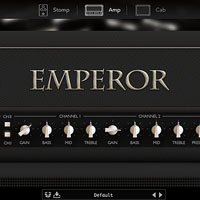PMI Emperor Piano for GS3
550 ₽
|  |
DVD. The final 24 bit grand piano libraries!!! EMPEROR: This library brings you an incredible Bцsendorfer 290 SE as the most realistic sample library available today. The piano has a huge dynamic range, with very subtle pianissimo and thunderous fortissimi. 12 recorded velocity layers, with 12 separate sustain pedal down layers and release triggered samples. OLD LADY: This library brings you an amazing Model 1923 Steinway D grand piano. Sampled with 10 recorded velocity layers with 10 separate sustain pedal down layers and release triggered samples.
The recorded piano was equipped with an advanced computer operated playback mechanism that was designed by mathematician, scientist and inventor Wayne Stahnke. The mechanism actually operates the piano keys and pedals with over 1.000 steps accuracy for inverse hammer velocity. The Stancke computer system enabled Amsterdam based sample library producer Michiel Post to capture each velocity layer for this library with absolute velocity levels. These levels guarantee a totally even response across the whole keyboard for all velocities. The programming of this piano is designed to take full advantage of the possibilities of the new GigaStudio 3 software. This results in more programmed velocity layers. The Emperor has 24 recordings for each key. These recordings were further divided in 64 velocity groups, each a slight variation of the underlying velocity layer sample. These libraries use a new programming to create the sustain pedal effect. Traditionally, conventional piano libraries use the sustain pedal as an ON-OFF switch, which has to be pressed before a note is played. These libraries lacked the possibility to re-pedal as in a real concert grand piano. Now this barrier has been broken. The PMI EMPEROR & OLD LADY libraries allow the user to press the sustain pedal at any time while playing notes or chords to start the sympathic resonance of the non-struck strings. There is a choice of convolution using the impulse response of the body resonance of the actual piano and a programming technique that adds the recorded resonance as an extra layer. GigaPulse (the convolution engine in GigaStudio 3) is also used for recreation of the original acoustics of the piano hall where the pianos were recorded.
Special features for GigaStudio 3: Body resonance for reproduction of the true body resonance upon sustain pedal use, Hall resonance, true re-pedalling, sustain pedal triggered pedal noise etc.
The recorded piano was equipped with an advanced computer operated playback mechanism that was designed by mathematician, scientist and inventor Wayne Stahnke. The mechanism actually operates the piano keys and pedals with over 1.000 steps accuracy for inverse hammer velocity. The Stancke computer system enabled Amsterdam based sample library producer Michiel Post to capture each velocity layer for this library with absolute velocity levels. These levels guarantee a totally even response across the whole keyboard for all velocities. The programming of this piano is designed to take full advantage of the possibilities of the new GigaStudio 3 software. This results in more programmed velocity layers. The Emperor has 24 recordings for each key. These recordings were further divided in 64 velocity groups, each a slight variation of the underlying velocity layer sample. These libraries use a new programming to create the sustain pedal effect. Traditionally, conventional piano libraries use the sustain pedal as an ON-OFF switch, which has to be pressed before a note is played. These libraries lacked the possibility to re-pedal as in a real concert grand piano. Now this barrier has been broken. The PMI EMPEROR & OLD LADY libraries allow the user to press the sustain pedal at any time while playing notes or chords to start the sympathic resonance of the non-struck strings. There is a choice of convolution using the impulse response of the body resonance of the actual piano and a programming technique that adds the recorded resonance as an extra layer. GigaPulse (the convolution engine in GigaStudio 3) is also used for recreation of the original acoustics of the piano hall where the pianos were recorded.
Special features for GigaStudio 3: Body resonance for reproduction of the true body resonance upon sustain pedal use, Hall resonance, true re-pedalling, sustain pedal triggered pedal noise etc.
Для получения более подробной информации о программе вы можете посетить сайт производителя.
Вы можете скачать PMI Emperor Piano for GS3 на нашем сайте.
Этот товар был выпущен 20.05.2009. Пожалуйста, проверьте совместимость с Вашим оборудованием и операционной системой.
Теги:
Отзывы
Написать отзыв
От: Ваш отзыв: Рейтинг: |

![Hypersonic 2 [64 Bit Edition] Hypersonic 2 [64 Bit Edition]](/images/hypersonic2.jpg)













![X-Treme FX [2 DVDs Set] X-Treme FX [2 DVDs Set]](/images/xfx.jpg)

